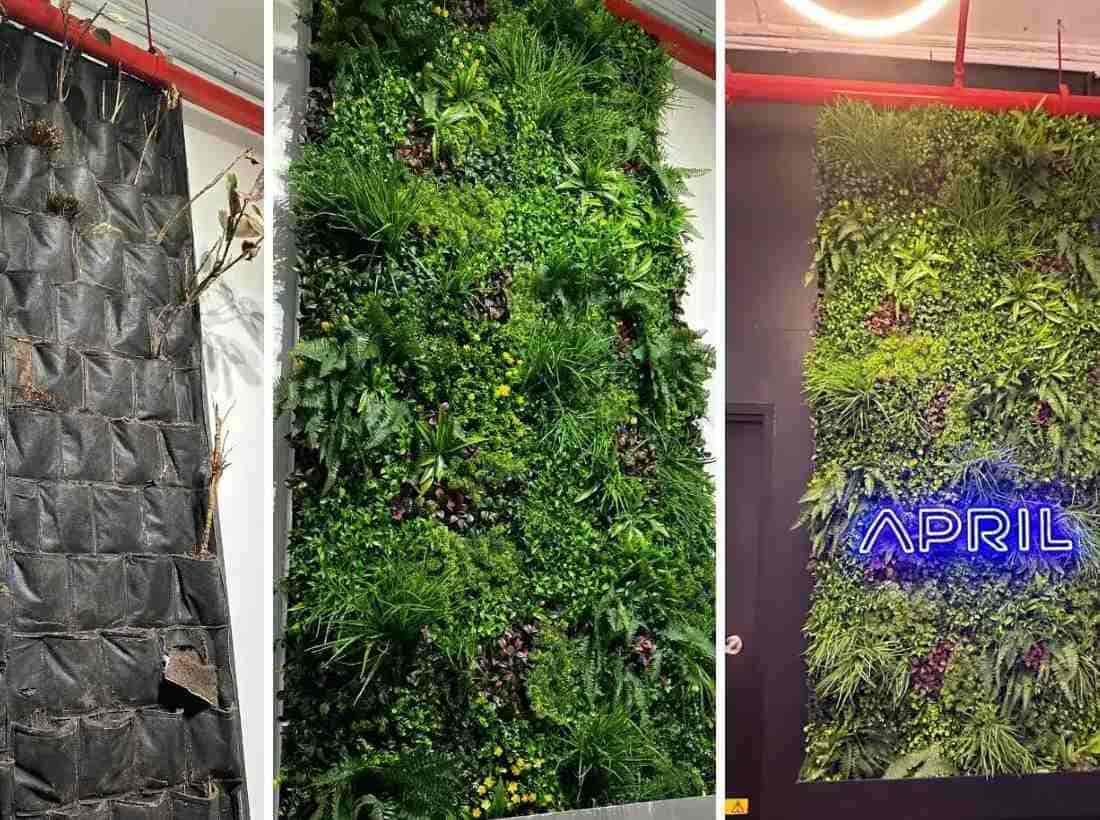It’s an exciting time for your space—you need a revamp and are looking for ways to make the most of it.
Nowadays, this doesn’t mean you must revamp your living quarters. You don’t have to tear down walls to change decor. You may only need something as simple as a bit of greenery on your wall.
But how do you decide what this greenery should be? Will you go natural or opt for artificial to save time?
How do you choose?
Don’t worry—we’re ready to do at least half the work for you. In this blog, we’ll talk about the pros and cons of artificial green walls vs. living green walls, how each stacks up, and how to compare them to choose the best option.
Ready to find your answer? Let’s dig in.
Pros and Cons of Artificial Green Walls
Let’s start with a new decor option available for your space, an artificial green wall. This product is a relatively new discovery but has made the rounds across the US.
Here’s what you should expect with faux vertical gardens:
Benefits of artificial vertical gardens
Let’s start with the good—what are the advantages of an artificial green wall? In our experience talking with many customers, we’d outline the following:
-
Durability: Artificial green walls are designed to be as durable and long-lasting as possible. Since they’re made of plastics, primarily LDPE, they’re likely to last for years due to the material’s toughness and corrosion resistance.
-
Low maintenance: A faux green wall doesn’t require watering, fertilizing, or pest control. You don’t need to cut back the foliage because it will stay the same shape its whole “life,” and all it asks for is the occasional dusting.
-
Customization: If you can’t find exactly what you need, you can ask the supplier to customize the panel for you. For example, Designer Plants can change the color, shape, and size of your faux plant so that it’s exactly as you like it.
-
Installation: Most faux vertical gardens are made with the intent of being DIY-friendly. This means you don’t need a professional building and installing crew to put up your panels because they’re very easy to do so yourself, even as a novice.
Drawbacks of artificial vertical gardens
On the other hand, there are some reasons you might shy away from using artificial green walls, including:
-
Lack of oxygen: Since faux green walls are made of plastic, they won’t provide the oxygen real greenery does. So, if you want to get the benefits of cleaner air, you should opt for a real green wall.
-
Less variety: You won’t find all types of vegetation on artificial vertical gardens. Since they need to be made following demand, many florals may not be replicated. Of course, if a supplier can make custom florals, you can avoid this issue.
-
Static: Artificial plants don’t grow. If you enjoy caring for living things and watching them change, a faux green wall won’t give you that satisfaction because they stay the same.
Why are artificial green walls becoming popular?
Greenery has the power to transform any space and add beauty, calmness, and charm. But for people short on time, limited by space, or simply not a fan of the upkeep of real plants, artificial green walls can be a practical and stylish solution.
Artificial vertical gardens have gained popularity for their ability to brighten indoor and outdoor spaces effortlessly. They’re lush, vibrant, and mimic the appearance of greenery without asking for regular maintenance. With just the occasional dusting, you can enjoy the aesthetic appeal of a lifelike green wall with peace of mind.
High-quality panels from reputable manufacturers are UV-tested and use recyclable materials. Many Designer Plants products, in particular, are also fire-certified and made with RoHS-compliant, toxin-free materials, which ensures safety for your family and pets.
Plus, they’re easy to assemble—just see how a client of ours reinvigorated their space with an artificial green wall after their living vertical garden died:

Pros and Cons of Living Green Walls
But what do living green walls have to offer? How do these panels enrich your life, and which drawbacks should you consider?
Benefits of real vertical gardens
Here are the leading advantages of real green walls and why you may ultimately decide to use them:
-
Air purification: Real green walls can filter and purify the air and balance the temperature and humidity of their surroundings. They release oxygen into the air and contribute to a more pleasant living space.
-
Attracts wildlife: Living vertical gardens encourage biodiversity and attract wildlife. If your panels are outside, you’ll enjoy the buzz and hum of bees, birds, and all kinds of animals who’ve come to admire your garden.
-
Changes and adapts: Since real plants adapt to the seasons, you’ll enjoy a garden with a changing appearance that never gets boring. If you get a flowering vertical garden, you might also enjoy budding flowers in spring, right in your home.
-
Constant growth: If you want to look after living things and love seeing young plants mature, a living vertical garden might be the best choice, as you can watch your panel develop over the years.
Drawbacks of real vertical gardens
Unfortunately, however, it’s not all rainbows and sunshine with natural green walls, either. If you decide to invest in one, here are some drawbacks you may encounter:
-
High maintenance: Living green walls require a lot of constant and consistent maintenance. They’re not a set-it-and-forget-it option because they need watering, fertilizing, and pruning, which can drain your time, money, and energy.
-
Pests: Since you’re looking after a mini garden, your space may become a hub for pests and insects. As a result, you’ll need to account for pesticides to ensure your vertical garden thrives. Unfortunately, this may come at the expense of your health.
-
Overgrowth: Real vertical gardens are prone to overgrowth, especially in spring. They’re also known to cause permanent structural damage like cracks from root penetration and chronic dampness from moisture retention.
Artificial Green Walls vs. Living Green Walls
So, you understand where artificial green walls and living green walls shine and fall short, but how do they compare head-to-head?
We’ll look at what both types of green walls offer for longevity, maintenance, installation, costs, etc. Then, we’ll choose a winner for each category.
We’ll be judging the green walls in 8 different categories:
-
Installation time
-
Maintenance
-
Costs
-
Durability
-
Environmental impact
-
Health and wellbeing
-
Life with pets
-
Aesthetics
Here’s how they stack up:
|
Criteria |
Artificial Plants |
Real Plants |
Winner |
|
Installation Time |
Quick and easy DIY installation with pre-assembled panels. Minimal expertise or professional help is required. |
Requires expert knowledge, irrigation systems, and significant time for setup. Higher installation costs due to complexity. |
Artificial |
|
Maintenance |
Low maintenance, with no watering, pruning, or pest control needed. |
High-maintenance, requiring watering, pruning, fertilizing, and pest control. Time-consuming and costly. |
Artificial |
|
Costs |
Higher costs upfront, but usually a one-time investment. No ongoing costs for maintenance. |
Lower costs upfront, but require ongoing maintenance cost during its lifetime. |
Tied, depends on personal budget |
|
Durability |
Resistant to pests, weather conditions, and environmental changes. Maintains appearance and quality in any environment. |
Vulnerable to pests, weather changes, and plant death. Not suited to high-traffic areas or fluctuating environments. |
Artificial |
|
Environmental Impact |
Made entirely of plastic, but can be recyclable. No water, pesticides, or chemicals are needed. |
Positive impact on reducing carbon, promoting biodiversity, and balancing temperature/humidity. Yet, needs plastic structures and pesticides. |
Real |
|
Health and Wellbeing |
Does not improve air quality but contributes to a visually calming atmosphere. |
Improve air quality, reduce stress, and create a natural, calming environment. |
Real |
|
Life with Pets |
Safe and non-toxic options are available. Would not be fatal if ingested. |
Depending on the type of plant, it may be toxic and fatal to pets who chew on it. |
Artificial |
|
Appearance |
Looks realistic if high quality, but fake if low quality. Maintains appearance year-round without maintenance, regardless of climate. |
Can look stunning but requires constant maintenance to retain appearance. Prone to dead patches from unregulated conditions. |
Tied |
Our comparison shows that artificial green walls excel in installation, maintenance, durability, and life with pets, while real green walls have notable advantages in environmental impact and health and wellbeing.
Here are our findings in an infographic:

The Verdict
As there are pros and cons for both options, in the end, it all depends on personal preferences. Choosing between artificial green walls vs. living green walls comes down to what you’re ready to shoulder for a green environment.
If you decide that an artificial vertical garden is right for you, we’re happy to offer you an extensive collection that suits many tastes. For bespoke advice, contact our team, and when you need inspiration, follow our Facebook and Instagram profiles.
FAQ
How long do artificial green walls last?
High-quality artificial green walls can last for up to 15 years indoors and 5 (and more) years outdoors with the proper care. To ensure your faux green walls stay around for a long time, look for suppliers with warranties.
What are the benefits of artificial green walls?
Artificial green walls are low-maintenance, easy to install, made of durable plastics that don’t degrade, non-toxic and safe for children and pets, and don’t attract pests or insects, making them a simple yet beautiful decor option.
Are green walls expensive?
High-quality faux green walls can be expensive, but the costs usually cover extensive testing, protective coatings, and premium materials.
How to clean a fake green wall?
To clean a fake green wall, you need to use a damp microfiber cloth to wipe the leaves. Alternatively, you can spray your green wall with a showerhead and then let it air dry or wipe it with a dry cloth.
What are artificial green walls made of?
Artificial green walls are typically made of LDPE, a type of durable and corrosion-resistant plastic that gives it flexibility and longevity. Some panels may also be made of other synthetic materials.
Is it better to have real or fake plants?
It depends on your personal preferences and how willing and able you are to care for and maintain your plants. If you have a green thumb and enjoy growing plants, a real plant would be better. But if you have a black thumb and little time to dedicate to upkeep, it’s best to opt for artificial plants.
Need help picking the best artificial plant for your space? Take this short quiz.


